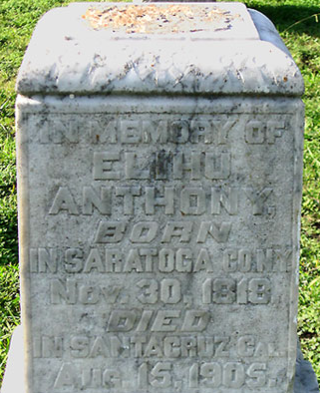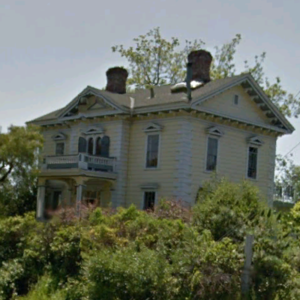Difference between revisions of "History Pages: 10 - The Territory"
(→Notes and references) |
|||
| Line 1: | Line 1: | ||
'''For a table of contents, see''' [[History pages]]. | '''For a table of contents, see''' [[History pages]]. | ||
| − | Although the Mexican-American War didn’t officially end until 1848, | + | Although the Mexican-American War didn’t officially end until 1848, most hostilities ended in California on January 13, 1847 with the [https://en.wikipedia.org/wiki/Treaty_of_Cahuenga Treaty of Cahuenga], only seven months after the Bear Flag revolt. From that treaty until statehood in 1850(1), California was U.S. occupied territory, under martial law and a military governor. These somewhat unsettled conditions were not ideal for attracting settlers, but the steady stream of new arrivals to the Santa Cruz area continued. Some of the men (nearly all were men) continued the pattern of the earlier 1840’s, finding work cutting timber, or milling it at Isaac Graham’s sawmill, at Joseph Majors’ gristmill, or at Paul Sweet’s tannery. Others came to build new mills. Like Graham's, these mills were powered by running water turning a wheel, so they had to be located on a good-sized year-round stream. Fortunately, our county has quite a few of those. |
[[File:Daubenbiss_house.png|thumb|The John Daubenbiss house in Soquel]] | [[File:Daubenbiss_house.png|thumb|The John Daubenbiss house in Soquel]] | ||
| − | Two of these early millwrights were [[Daubenbiss, John|John Daubenbiss]] (originally with just one "s"), a native of Bavaria, and John Hames of New York. In 1846, the two were contracted by Michael and Martina Castro Lodge to build a sawmill at Rancho Soquel, on Soquel Creek. These two stayed on to become leading citizens of Soquel village. Twenty years later, Daubenbiss built the home on the hill that remains one of Soquel’s prominent landmarks. Daubenbiss' brother Henry followed John to Santa Cruz, and Hames’ brother Benjamin later followed John, settling in the Pleasant Valley neighborhood of Corralitos. His name is remembered on today’s Hames Road. | + | Two of these early millwrights were [[Daubenbiss, John|John Daubenbiss]] (originally with just one "s"), a native of Bavaria, and [[Hames, John|John Hames]] of New York. In 1846, the two were contracted by [[Castro family|Michael and Martina Castro Lodge]] to build a sawmill at Rancho Soquel, on Soquel Creek. These two stayed on to become leading citizens of Soquel village. Twenty years later, Daubenbiss built the home on the hill that remains one of Soquel’s prominent landmarks. Daubenbiss' brother Henry followed John to Santa Cruz, and Hames’ brother Benjamin later followed John, settling in the Pleasant Valley neighborhood of Corralitos. His name is remembered on today’s Hames Road. |
| − | The redwood forests of the San Lorenzo | + | The redwood forests of the [[San Lorenzo River|San Lorenzo River watershed]] also saw new sawmills, as demand for construction lumber increased. Graham built a second mill in 1845, and newcomer Vardamon Bennett came south to San Jose from San Francisco in 1847, with his wife Mary Amanda and several sons, who built one farther upstream, near the mouth of what later became known as Love Creek (Bennett's widow Mary married lawman [https://en.wikipedia.org/wiki/Harry_Love_(lawman) Harry Love]. Bennett's daughter Catherine later had a brief and stormy marriage with Isaac Graham(2). Bennett Creek, however, which flows into the San Lorenzo at Felton, was named for [[Bennett, Eben|Eben Bennett]] (apparently no relation), a New Yorker who arrived in 1866 to become a lime-manufacturer. |
[[File:Anthony_headstone.png|thumb|left|320px|Anthony gravesite in [[Santa Cruz Memorial cemetery]]]] | [[File:Anthony_headstone.png|thumb|left|320px|Anthony gravesite in [[Santa Cruz Memorial cemetery]]]] | ||
Revision as of 17:28, 4 December 2022
For a table of contents, see History pages.
Although the Mexican-American War didn’t officially end until 1848, most hostilities ended in California on January 13, 1847 with the Treaty of Cahuenga, only seven months after the Bear Flag revolt. From that treaty until statehood in 1850(1), California was U.S. occupied territory, under martial law and a military governor. These somewhat unsettled conditions were not ideal for attracting settlers, but the steady stream of new arrivals to the Santa Cruz area continued. Some of the men (nearly all were men) continued the pattern of the earlier 1840’s, finding work cutting timber, or milling it at Isaac Graham’s sawmill, at Joseph Majors’ gristmill, or at Paul Sweet’s tannery. Others came to build new mills. Like Graham's, these mills were powered by running water turning a wheel, so they had to be located on a good-sized year-round stream. Fortunately, our county has quite a few of those.
Two of these early millwrights were John Daubenbiss (originally with just one "s"), a native of Bavaria, and John Hames of New York. In 1846, the two were contracted by Michael and Martina Castro Lodge to build a sawmill at Rancho Soquel, on Soquel Creek. These two stayed on to become leading citizens of Soquel village. Twenty years later, Daubenbiss built the home on the hill that remains one of Soquel’s prominent landmarks. Daubenbiss' brother Henry followed John to Santa Cruz, and Hames’ brother Benjamin later followed John, settling in the Pleasant Valley neighborhood of Corralitos. His name is remembered on today’s Hames Road.
The redwood forests of the San Lorenzo River watershed also saw new sawmills, as demand for construction lumber increased. Graham built a second mill in 1845, and newcomer Vardamon Bennett came south to San Jose from San Francisco in 1847, with his wife Mary Amanda and several sons, who built one farther upstream, near the mouth of what later became known as Love Creek (Bennett's widow Mary married lawman Harry Love. Bennett's daughter Catherine later had a brief and stormy marriage with Isaac Graham(2). Bennett Creek, however, which flows into the San Lorenzo at Felton, was named for Eben Bennett (apparently no relation), a New Yorker who arrived in 1866 to become a lime-manufacturer.

Another upstate New Yorker came to Santa Cruz in 1847. Elihu Anthony was not a miller, but an blacksmith who saw a local need for the manufacture and repair of metal mill machinery, agricultural tools and other metal items. The only parcel of town land he found for sale, however, was mostly down in the flood-prone flats on the west bank of the San Lorenzo. Undeterred, he built a foundry/blacksmith business there, near where the Town Clock is today. That construction began the town center’s move down from Mission Hill. We’ll hear more about Elihu Anthony’s activities in coming years, as he became one of the most important early commercial/industrial builders of Santa Cruz.
The Santa Cruz area was growing, although still somewhat slowly. At the beginning of 1848, the leisurely pace of life on the Ranchos was only slightly disturbed by the noise of many axes, a few sawmills, and the grinding of a few grist mills. That quiet life was soon to change forever, as news arrived of a momentous discovery in the far-off Sierra Nevada foothills – gold!
Notes and references
- California actually began self-governance in November 1849, although statehood didn't arrive until Sept. 9, 1850 - Admission Day.
- Quite Contrary, The Litigious Life of Mary Bennett Love (2014 book)
